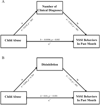Adolescent nonsuicidal self-injury: examining the role of child abuse, comorbidity, and disinhibition
- PMID: 25095754
- PMCID: PMC4252370
- DOI: 10.1016/j.psychres.2014.07.027
Adolescent nonsuicidal self-injury: examining the role of child abuse, comorbidity, and disinhibition
Abstract
The purpose of the study is to examine how several well-known correlates of nonsuicidal self-injury (NSSI) might work together to contribute to the occurrence of this behavior. Specifically, we examined models including child abuse, psychiatric comorbidity, and disinhibition, testing how these factors may work together to lead to NSSI in the past month. Participants (n=194; 144 female; age 13-18 years) were recruited from a short-term, acute adolescent residential unit. Within 48 hours of admission to the hospital participants completed structured clinical interviews assessing mental disorders and patterns of NSSI. Following the interviews, participants completed a self-report questionnaire assessing childhood abuse and a computerized continuous performance task. Consistent with study hypotheses, results revealed that the association between child abuse and NSSI is partially mediated by comorbidity. Although disinhibition is associated with comorbidity, contrary to our hypothesis, disinhibition does not mediate the relation between child abuse and NSSI. Collectively, these findings provide new information about how comorbidity may increase risk for NSSI, and critically, discuss the potential importance of creating targeted programs to reduce the prevalence of child abuse.
Keywords: Child abuse; Comorbidity; Disinhibition; Impulsivity; Nonsuicidal self-injury.
Copyright © 2014 Elsevier Ireland Ltd. All rights reserved.
Figures
References
-
- Abela JR, Aydin C, Auerbach RP. Operationalizing the "vulnerability" and "stress" components of the hopelessness theory of depression: a multi-wave longitudinal study. Behaviour Research and Therapy. 2006;44(11):1565–1583. - PubMed
-
- Allman JM, Hakeem A, Erwin JM, Nimchinsky E, Hof P. The anterior cingulate cortex. Annals of the New York Academy of Sciences. 2001;935(1):107–117. - PubMed
-
- Baron RM, Kenny DA. The moderator-mediator variable distinction in social psychological research: conceptual, strategic, and statistical considerations. Journal of Personality and Social Psychology. 1986;51(6):1173–1182. - PubMed
Publication types
MeSH terms
Grants and funding
LinkOut - more resources
Full Text Sources
Other Literature Sources
Medical
Miscellaneous


